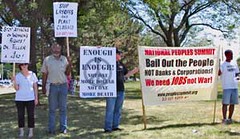
Supporters of the Moratorium NOW! Coalition to Stop Foreclosures, Evictions and Utility Shut-offs held a demonstration outside Macomb Community College during President Obama's visit demanding a bailout of the people. (Photo: Kris Hamel)
Originally uploaded by Pan-African News Wire File Photos
New York Times Editorial
Foreclosure Prevention 2.0
If all goes according to plan, the Obama administration’s new antiforeclosure effort will prevent many more foreclosures than its current one and do more to moderate the decline in home prices. That is a big if.
One of the big drawbacks to the administration’s original plan, launched a year ago, is that it focuses on reducing a troubled borrower’s monthly payment by lowering the interest rate. That ignores the fact that unemployed borrowers often cannot afford even reduced payments. And those who are “underwater” — who owe more than their homes are worth — often lack the ability and the incentive to keep up with payments.
Another problem with the original plan is that participation has been largely voluntary; lenders were offered incentives to join but were not compelled. The improved plan attempts to address the problems of borrowers who are unemployed or underwater. And for jobless homeowners, lenders that participate in the plan will be required to help in some cases.
For borrowers receiving unemployment benefits, lenders will be required to lower payments to no more than 31 percent of gross income for at least three months, provided the borrower is not more than 90 days’ delinquent. Unpaid amounts will be added to the loan’s principal, to be repaid later. After several months, the hope is that the borrower will have found new work and will qualify for a loan modification in which payments will stay at the reduced amount.
Unfortunately, if the borrower does not find new work, he or she may lose the house anyway. Foreclosure will have been postponed, but not prevented.
For borrowers who are deeply underwater and behind in their payments, lenders will be “required to consider” reducing the loan’s principal. They will also be encouraged to reduce principal for underwater borrowers who are still current in payments.
Those efforts would reduce the monthly payment and restore some home equity, but as with earlier antiforeclosure efforts, lenders are not required to help. Despite government incentives to modify bad loans, lenders might wait to see if bigger incentives are offered later. They may also prefer foreclosure to modifications because the long foreclosure process lets them postpone taking losses.
If lenders do participate, the new plan could prevent nearly 1.5 million foreclosures from now through 2012, compared with an estimated 650,000 under the old plan, according to Moody’s Economy.com. Many foreclosures will also be delayed, though not ultimately prevented, as lenders assess whether borrowers qualify for help under the new plan. Taken together, preventing and postponing foreclosures would help stabilize house prices in the near term and thus reduce the threat that foreclosures pose to the nascent economic recovery.
But foreclosures would still be a problem. Even if the new plan saves 1.5 million homes, an estimated 3.6 million homes will be lost between now and 2012. That portends a weak housing market for a long time, which, in turn, portends a long, slow recovery.
For now, lenders call the shots. If the new plan doesn’t work, the administration must find a way to compel them to rework troubled loans. The risks from the spree of bad lending and bad borrowing — foreclosures, falling house prices, economic hardship — are still there.
No comments:
Post a Comment